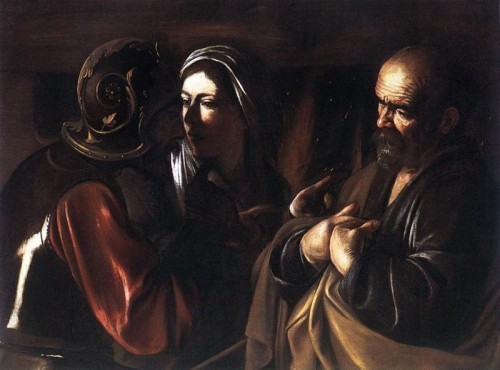Daily Caravaggio: The Denial of St. Peter
Late Caravaggio tells story of a biblical scene with a few gestures

In his later paintings, Caravaggio made himself into a master of suggestion, letting the story of the scene emerge from the darkness in its most telling gestures. The Denial of St. Peter, which is at the Metropolitan Museum of Art in New York, is the finest example of this shadowed storytelling. In my Caravaggio novel, I have the artist's old patron Cardinal del Monte figuring out the messages behind the gestures.
To coincide with the UK paperback publication of my Caravaggio novel A NAME IN BLOOD, I'm posting each of the paintings that appear in the book this month along with a snippet from the novel.
Here's del Monte and Caravaggio in Naples, after the artist has been on the run for years:

In his later paintings, Caravaggio made himself into a master of suggestion, letting the story of the scene emerge from the darkness in its most telling gestures. The Denial of St. Peter, which is at the Metropolitan Museum of Art in New York, is the finest example of this shadowed storytelling. In my Caravaggio novel, I have the artist's old patron Cardinal del Monte figuring out the messages behind the gestures.
To coincide with the UK paperback publication of my Caravaggio novel A NAME IN BLOOD, I'm posting each of the paintings that appear in the book this month along with a snippet from the novel.
Here's del Monte and Caravaggio in Naples, after the artist has been on the run for years:
They went back to the Stigliano Palace. In the studio, Caravaggio pulled away the cloth that covered a painting of a bald, bearded man, a woman and a soldier. The man turned his hands to his chest and pulled in his chin, denying some accusation. ‘St Peter.’
Del Monte went close to the canvas. He glanced sidelong at Caravaggio. The man makes so many bad decisions, he thought. How can he produce such judicious art, such insight into the way people are, and yet not be a saint? ‘It’s so immediate, Michele.’ He let his hands follow the lines of the brush like a musician conducting an ensemble. ‘Peter almost looks as you might, when you’re an old man.’
‘I hope to live so long.’
Michele gave his own face to Peter at the moment of his guilty denial of Christ, del Monte thought. The saint pointed at his heart to show sincerity, but it was the lying manoeuvre of a desperate man. In his expression, del Monte saw that he was guilt-ridden. His eyes didn’t quite rest on the face of the soldier interrogating him. They were distant, looking over the soldier’s shoulder.
Del Monte turned to Caravaggio in surprise. He’s ashamed of himself. ‘St Peter overcame his guilt. Remember that, Michele. He went to found the Church in Rome.’
‘Where he met his death.’
In the dark studio, Caravaggio’s face was shadowed. His wounds marked him as an insulted man. They glinted like silver highlights on black cloth.
Published on September 09, 2013 03:47
•
Tags:
art-history, caravaggio, covers, crime-fiction, food, historical-fiction, italy, rome
No comments have been added yet.



